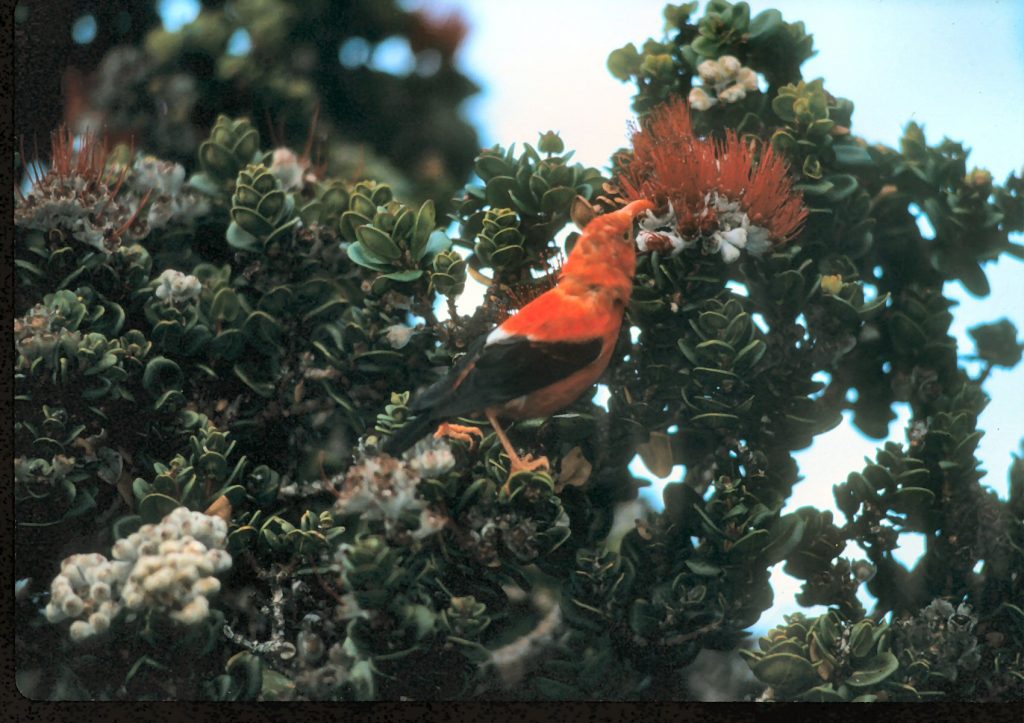Lawsuit Aims to Protect ʻIʻiwi, Threatened Iconic Hawaiian Forest Bird

The Center for Biological Diversity on Wednesday filed a lawsuit against the US Fish and Wildlife Service for allegedly “failing to designate critical habitat and develop a recovery plan” for the threatened ‘i‘iwi, one of Hawai‘i’s imperiled honeycreepers.
‘I‘iwi are medium-sized Hawaiian forest birds known for their iconic bright red plumage, black wings and distinctive long, curved bill.
Because of the extensive threats of mosquito-borne diseases, rapid ‘ōhi‘a death—an invasive fungal disease that is killing ‘ōhi‘a trees at an alarming rate—and climate change, the Service listed the ‘i‘iwi as threatened on Sept. 20, 2017.
The Endangered Species Act required the agency to designate critical habitat with its listing determination and develop a recovery plan for the bird, but the Center reports that the Service “failed to do so.”
Maui Now reached out to the agency on Wednesday and did not receive a response at the time of this posting. (This story will be updated if additional information is received).
Maxx Phillips, the Center’s Hawai‘i director and staff attorney, called the delay “unacceptable,” and said without the protections provided by critical habitat and a valid recovery plan, “‘i‘iwi will continue down a heartbreaking path towards extinction.”
The ‘i‘iwi was once one of the most abundant native forest birds across Hawai‘i. The CBD reports that it “now persists on only three islands, with the population on Kaua‘i likely to go extinct within 30 years.”
According to the CBD, like many native Hawaiian forest birds, ‘i‘iwi have an extremely low resistance to avian malaria, with an average 95 percent mortality rate. “The combination of low resistance and high mortality means that nearly every ‘i‘iwi that comes into contact with avian malaria dies from the disease,” according to the Center for Biological Diversity.
Since mosquitoes can’t live at higher elevations because of cooler temperatures, ‘i‘iwi have survived in higher-elevation forests. “But as the impacts of global climate change continue to accelerate, temperatures at higher elevations in Hawai‘i are increasing at an unforeseen rate. This warming allows mosquitoes to expand their range into higher elevations, bringing with them avian malaria and avian pox. Additionally, the virus that causes avian malaria survives better in warmer temperatures, meaning warmer high elevation habitats will no longer be safe refuges from the disease,” according to the CBD.
Phillips said, “In particular, we have to restore forests at higher elevations on the Big Island to give ‘i‘iwi space to move uphill and do whatever we can to control mosquitoes on all the islands.”
The lawsuit was filed in US District Court for the District of Hawaiʻi.
The CBD reports that some 68 percent of Hawai‘i’s known endemic bird species have already gone extinct because of habitat loss, disease and invasive predators.
According to the CBD, of the remaining 37 surviving endemic species, 33 are currently listed under the Endangered Species Act, although nine of these have not been observed recently and are thought by scientists to be extinct. Introduced mosquitoes and the diseases they carry are primary causes of the loss of all these birds, according to the CBD.










